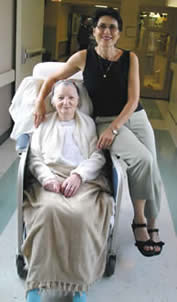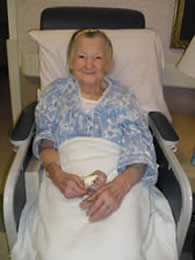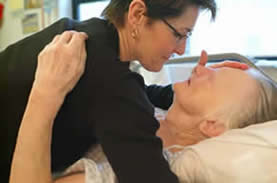Loretta S. Downs
Chicago, Illinois, USA
My mother’s end-of-life was 15 years long. It began the day my father died and she became dependent upon her children to fill the roles he had played throughout their 61-year marriage.
 |
| Loretta Downs and Mom by Loretta Downs |
We managed relatively well, and her health continued to be good for nearly seven years. By the time she reached 86, she had lost enough physical strength and emotional stamina that the house she had treated like a lover for 54 years became her enemy. Refusing any outside help, she learned to mix cement to patch cracks in the steps, found clever ways to insulate the windows, and successfully taped things that needed screws. She worried about burglars. The day she called to tell me we had won the lottery brought us to a new crossroads.
It took three months visiting her on a psychiatric ward before we could face the decision to move her to a little apartment in an independent living facility. We were forced to sell her house, the house we always thought she would die in. Decorating the studio apartment with a view of the lake, I tried to convince her it was like living on a cruise ship. Eventually, she made friends. She grew to enjoy having someone else to do the cleaning and cooking.
Two years into this bliss, on her 88th birthday, she lost her ability to walk. It was as though her warranty had run out. This triggered another hospitalization and a move into skilled care. We did not adjust well to nursing home life. My mother didn’t speak to me for months. She refused to go out of her room and missed the Christmas party. It took us a year to adjust to being in a place where people seemed to slowly die, but, with acceptance, we were able to provide her with the best quality of life we could under the circumstances. We made friends and found gratitude that mother’s mind was as good as her appetite.
These moments of calm notwithstanding, during those 15 years of physical decline she—we—experienced twelve emergency room visits, five major hospitalizations, eight years in custodial institutions, and countless meetings with medical professionals. Not once did anyone mention advance directives to us. Although these major medical events were radical turning points in her health status, with each change giving us a green light to open a conversation about future planning, we did not. All of those distinct opportunities to talk about our mother’s goals of care were missed because not one medical provider broached the subject.
We stumbled from crisis to crisis, tripping over our discomfort at using “The D Word” despite an obvious, progressive decline toward her inevitable death. We needed our medical professionals to recognize these turning points and discuss the various ways to support our mother and care for her in ways that she wanted at the end of her life..
Finding peace
It was the 2005 Terri Schiavo case that brought my awareness to the potential tragedy awaiting us, and that gave me courage. My mother was 92 by then. One day we were together in her bed sharing a cup of coffee with ice cream in it when I casually asked, “Do you ever think about the future, Mom?”
She looked straight at me and replied, “I’m living my future.”
 |
| Mom smiling by Loretta Downs |
I gazed into her eyes, the same ones that define my face, and asked tentatively, “What if something happens to you and you can’t talk. What do you want us to do?”
She slowly turned her head forward, stared at the wall covered in photos and greeting cards, and said softly, “You girls will know what to do.”
Not long after my mother gave my sister and me her complete trust to do what we felt was right for her, she was found unresponsive by the aide delivering lunch and was sent to the hospital. We took a sharp turn at high speed.
She could not be roused to eat or talk, though a battery of tests showed no reason for the condition. A few days into this semi-conscious state—with my keeping 24-hour vigil at her bedside—an unfamiliar doctor took me into the hall and crisply said, “Your mother needs a feeding tube, or she’ll starve to death.” I took a deep breath, let tears flow, and calmly replied, “Let’s call hospice instead.”
Taking the final turn from curative into palliative care with hospice does not come easily for anyone—ever. It certainly does not come easily when the professionals who know that death is approaching cannot acknowledge it. Caregivers are desperate for guidance. We are more able to take it when it is continuous, consistent, and focused on our personal goals than when, in a crisis, counsel is given by strangers who do not understand our values. I needed to be told, “These are the options for her care at this point. What would your mother want? How can we make this time positive for her and for you? How can we provide her with a gentle death?”
I did not want my mother to leave me, to die when we had just begun to know each other, to be in love with each other. The last three years of her life were the best years of our relationship. I didn’t want to let go, but so much of what gave her life meaning had been replaced with pain and suffering. I needed to let her go. I needed to accept her mortality.
Within what seemed like minutes, a hospice nurse was in her room explaining what I might expect of the dying process and the services they would provide along the continuum. Mother was returned to her home at the Fairmont Care Center, and I moved into her room with an air mattress to keep vigil. Three days later she sat up and asked, “Where’s my lunch?”
At peace
Mom thrived as a hospice patient. The added attention from the compassionate hospice workers, the nursing home staff, and her family were sufficient reasons to “keep on going” as she liked to say. After three months she was discharged from hospice care. On discharge, my mother was happy for the first time in a great while. She had used her time in hospice, as had I, to make peace with her life.
 |
| Looking into Mom’s eyes by Todd Hochberg |
Accepting hospice was the acknowledgment of her nearing death, and that alone allowed everyone around her to focus on her comfort and the meaning of every minute spent with her. During the next four months we cared for her with massive doses of love and time and sweet treats. Then she had a stroke. In the emergency room her face and right arm were slack, but the grip of her left hand on mine was like a vise. A doctor examined her and asked me some questions. He wanted to admit her to the hospital for tests, but I chose hospice one more time. When she heard me say, “We’re taking her home,” Mother let go of my hand.
We returned to the Fairmont Care Center in Chicago and moved into the Chrysalis Room. Unlike most nursing home rooms—which frequently allow no space for visitors, let alone a whole family—the Chrysalis Room is a hospice room arranged like a hotel suite where residents and family can visit and even stay overnight. The room’s environment supports the dying process with privacy, comfortable furnishings, tranquility, and palliative care. It is a sacred space created to encourage the work of final transformation. Through eight days of vigil and the hours following her death, Mother and I were supported, comforted, and cared for by loving hands. She died in peace, with my arm around her.
Although I know I made the right decision for my mother, I wish she had been able to tell me her end-of-life decisions the way I am able to tell my health care proxy about mine. But we were faced with a new and unexpected dilemma in her last years. For the first time in the country’s history, many Americans are living longer lives thanks to the advent of medical technology. We have no role models for the end-of-life we are facing. Until we are faced with the death of a loved one or our own unexpected illness, many of us may not understand that a decision to forego treatment is necessary before we are allowed to die. In the absence of such a decision, we may rush from medical crisis to medical crisis, prolonging suffering while forgoing our last precious moments with loved ones.
When caregivers and medical providers are unable to talk about the inevitable arrival of death, the opportunities for quality care at the end-of-life are too often missed. In those 15 years that marked my mother’s last years, what she and her children desperately needed were crossing guards at every turning point who could say to us, “Let’s talk about how you want to live your future.”
LORETTA S. DOWNS, MA, speaks and writes about supporting positive experiences at the end of life. She founded Chrysalis™ End-of-Life Inspirations to advocate for nursing homes and hospitals to provide private rooms making it possible for loved ones to keep vigil with the dying. She is president of the Chicago End-of-Life Care Coalition, a Certified End-of-Life Care Practitioner, and a Respecting Choices™Advance Care Planning Facilitator. She is a member of the Advocate Illinois Masonic Medical Center ethics committee, the Association for Death Education and Counseling, the American Society on Aging, the Society for the Arts in Health Care, and the Pioneer Network. She holds a master’s degree in Gerontology.
Highlighted in Frontispiece Spring 2011 – Volume 3, Issue 2
Spring 2011 | Sections | End of Life

Leave a Reply